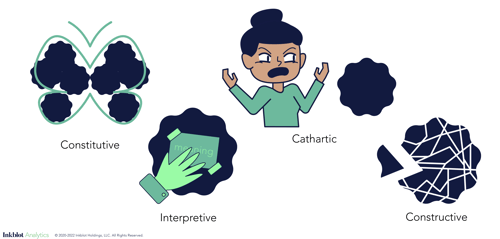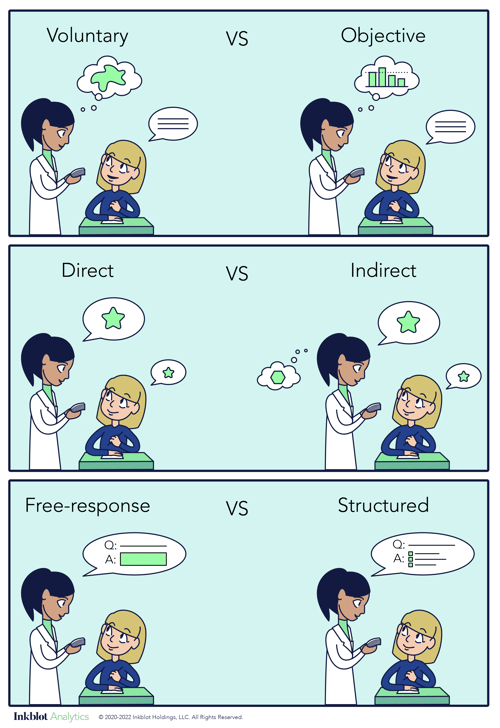What Are Projective Tests?
If you think you know what projective tests are, you may only know half the story.
The inception of projective testing provided a springboard for all kinds of innovation and the creation of new testing methods.
“Since psychology only deals with motion—processes occurring in time—none of its proper formulations can be static.” —Henry Murray (1938, p. 36)
In the last post, we outlined the projective hypothesis—the foundation of all projective methods—and the necessary conditions of projective test development that logically flow from the projective hypothesis. But the projective hypothesis and the 4 necessary conditions that flow from it still leave a lot of room for projective test innovation. Consequently, since its inception, the types of projective tests have grown. And just like we saw in the post about projection, a taxonomy of conceptual differences is needed.
Over the span of twenty years (1939-1959) several influential psychologists laid the foundation for classifying the different types of projective tests. The logic behind each classification system at times builds upon one another in an embedded and iterative manner.
The first attempt at classification was taken by Lawrence Frank (1939), who coined the term “projective methods.” Frank based his classification on the activity performed by the individual in the stimulus-situation:
Constitutive responses occur when a subject “imposes structure upon” an ambiguous, partly organized, or completely unstructured stimulus (Frank, 1939, p. 403). For example, a person might see an object—like a bird’s wing—in an inkblot.
Interpretive responses take place when a subject assigns personal meaning to a stimulus-situation. Building on the inkblot example, the person might say that wings “are a strong symbol that guides me.”
Cathartic responses happen when a subject expresses a feeling that releases emotion; revealing an underlying disposition to the stimulus-situation. Upon further questioning, the person reveals that they once owned a pet bird, and that the sight of a wing brings them both joy and anguish. However, cathartic response may also be more direct, as with the case of dollplay or psychodrama.
Constructive responses take place when a subject organizes test materials; revealing patterns of their life conceptions. In this case, the subject may be asked to assemble blocks or toys.

While Frank focused on responses in a stimulus-situation, Sargent (1945) proposed another classification that went beyond just that one area of the test.
Just like Frank, Sargent focused part of his classification on the functional use of materials in the stimulus-situation. Sargent cite’s Frank’s initial classifications but elaborates on the fact that Frank’s categories are not necessarily mutually exclusive. More specifically, sometimes the material used can span multiple functional uses.
The nature of materials used in projective tests are a second category of classification for Sargent. According to Sargent’s analysis, materials used in projective tests are diverse, ranging from inkblots—which have definite structures that allow for codified content responses—to pictures and pattern mosaics. Additional materials include blocks, dramatic play, stories, verbal summators, and even art media like clay or fingerpainting.
The presentation techniques used by the experimenter can be differentiated by experimental control used and therefore the degree of interpretation allowed. Experimental control is about the materials used, and its degree of structure. The more structured (in material and presentation to respondent) the less “interpretation needs to be done. The less structured, the more interpretation needs to be done.” Sargent advised that the less structured a chosen material is, the more uninhibited the subject’s response is. Thus there is an inverse relationship with structure and range of response, but a positive relationship between structure and meaning.
The purposes of the various applications can be divided into three subsets: diagnosis (clinical use in psychiatry), therapy (insight into pathogenic factors and therapeutic release), and experiment (research/investigative purposes).

In 1957 Donald Campbell continued to build on the work of Frank and Sargent. However, Campbell structured the typology into 3 dichotomies.
Voluntary vs objective tests. A voluntary test is what is often thought of today as a “subjective” test. These tests encourage uninhibited responses because there is no “right” answer per se. There is neither a criterion nor benchmark to compare a subject’s response to. On the other hand, in objective tests there is a right answer. Or as Campbell wrote, “the concepts of accuracy and error are in the subject’s mind,” (Campbell, 1957, p. 207). It is worth noting that objective tests still can elicit subjective (i.e. natural, genuine) projections.
Direct vs indirect tests. Direct tests have full transparency in the sense that both the participant and the examiner are aware of the test’s purpose. Conversely indirect tests follow the rule of deception—meaning that the subject is unaware of the test’s purpose because it is intentionally disguised by the examiner. Campbell offered the following example of an indirect test, “If a person tells stories to pictures under the belief that his thematic creativity is being measured, and the psychologist then interprets the products as depth projections, the test is indirect,” (Campbell, 1957, p. 208).
Free-response vs structured. A test that is characterized by “free-responses” is one that allows for responses without suggestion or limitations. Structured tests—the gold standard of personality measurement before the projective movement—provide strict organization for the subject, rather than, “allowing the respondent to project his own organization upon the material” (Campbell, 1957, p. 208). You can think of the typical Likert scale questions in a personality battery for an example of a “structured” test.

Based on these three dichotomies Campbell produced eight types of tests, though three are not considered projective. Based on Rapaport’s sufficient criteria for a method to be projective, we ought to solely consider Campbell’s five projective test types:
Voluntary, Indirect, & Free-Response tests category house the majority of the classic projective techniques, such as the Rorschach and the Thematic Apperception Test.
Voluntary, Indirect, & Structured tests commonly feature multiple-choice versions of classic projective techniques.
Voluntary, Direct, & Free-Response tests are occupied by sentence completion tasks, open-ended surveys, and essays.
Objective, Indirect, & Free-Response are where the examiner uses deception, yet allows for an uninhibited response. Campbell proffers the example of the Verbal Summator test, where an individual constructs verbal content from vague vowel sounds.
Objective, Indirect, & Structured tests commonly feature structured versions of previous category’s projective techniques, for example the error-choice test.
Gardner Lindzey, former president of the American Psychological Association, created a self-proclaimed best attempt at classifying projective techniques that would produce “a profile for each projective test, representing its classification according to a variety of criteria” (Lindzey, 1959, p. 166). He considered the contributions of all three founders prior to him [Frank, Sargent, and Campbell]. In doing so, Lindzey generated six major classification categories, placing a heavy emphasis on the primary category: mode of response.
1. Mode of Response.
Associative techniques require a subject to respond to a stimulus without reflexion or reason— their primary response, no matter its peculiarity—the test is said to be associative. This type of test elicits Frank’s private world and Campbell’s depth projections. Popular examples are the Rorschach and the Word Association Test.
Construction techniques “require the Subject to engage in complex, cognitive activities, beyond mere association” (Lindzey, 1959, p. 163). These tests produce valuable products that are subject to modification. In other words, they are not concerned with an individual’s behavior or manner of response. The most famous example is the Thematic Apperception Test.
Completion techniques invite subjects to essentially fill in the blanks in a rational, but idiosyncratic manner. The response is typically more complicated and takes more time. If you had to complete this sentence, what would you ___?
Choice or Ordering techniques give a set of items that fit a specific benchmark like, “correctness, relevance, attractive- ness, or repugnance,” and choose the category that is self suiting (Lindzey, 1961, p. 164). In essence, the subject responds to hypotheticals, such as in the Picture Arrangement Test.
Expression techniques are unlike constructive tests because they are chiefly concerned with the manner or style in which a product is created. Examples include drawing and painting tests, as well as play-techniques.
2. Stimulus attributes are the different sense modalities involved. For example: visual, auditory, or tactual. The structure of the stimulus, or lack thereof, can also be used to classify projective tests within this category. For example, drawing and play techniques appeal to multiple sensory modalities.
3. Interpretation refers to the means by which the examiner interprets the test. Do they focus on the manner the task was performed—for example frequency and speed of response—or do they focus on the content or meaning of the subject’s response (Lindzey, 1959, p. 160)? Additionally, projective tests may be further classified by the approach on personality, dimensional or holistic. While the Rorschach touches on all four categories, it traditionally emphasizes a formal, holistic approach.
4. The purpose of the test may range from general personality descriptions, to assessments of specific attributes, to the identification of diagnostic groups (Lindzey, 1959, p. 165). The Word Association Test mainly emphasizes the assessment of specific attributes.
5. The method of administration can be to an individual or group. Additionally, some tests can be self administered. Another critical consideration is in the structure of the responses: are they restricted or free? Perhaps surprising to the reader, the Sentence Completion Test is traditionally administered to groups.
6. The method of construction differentiates empirical and rational tests. Empirical tests do not consider theory or rationale behind the association between a given response and a personality feature. On the other hand, rational tests are concerned with “underlying processes and intermediary factors” (Lindzey, 1959, p. 161).
By now we hope that you have cultivated an appreciation for the complex nature of projective tests. There are a number of ways to classify projective tests because of the diverse nature of projective test innovation.
However, having fallen out of style, project test development has slowed down, and not many researchers have tried to reclassify them all. However, at Inkblot Analytics, with the release of our digital inkblot tests and our patent-pending platform, we have found a new way to classify projective tests. If you’re interested in learning more please feel free to contact us.
References:
Allport, G. W. (1937). Personality: a psychological interpretation. New York: Holt. 48.
Campbell, D. T. (1957). A typology of tests, projective and otherwise. Journal of Consulting Psychology, 21(3), 207–210.
Frank, L. K. (1939). Projective methods for the study of personality. Journal of Psychology. 402-403.
Lindzey, G. (1959). On the classification of projective techniques. Psychological Bulletin, 56(2), 158–168.
MURRAY, H. A. (1936). Explorations in personality. New York: Oxford Univ. Press. 36.
Sargent, H. (1945). Projective methods: their origins, theory, and application in personality research. Psychological Bulletin, 42, 257-293.
If you think you know what projective tests are, you may only know half the story.
No matter how much you’ve heard about projective tests, they are not what you think they are.
Discover how psychologists used general principles and conceptual similarities of projection to establish the sub-discipline of projective...
Be the first to know about new psychological insights that can help you optimize customer touchpoints and drive business growth.